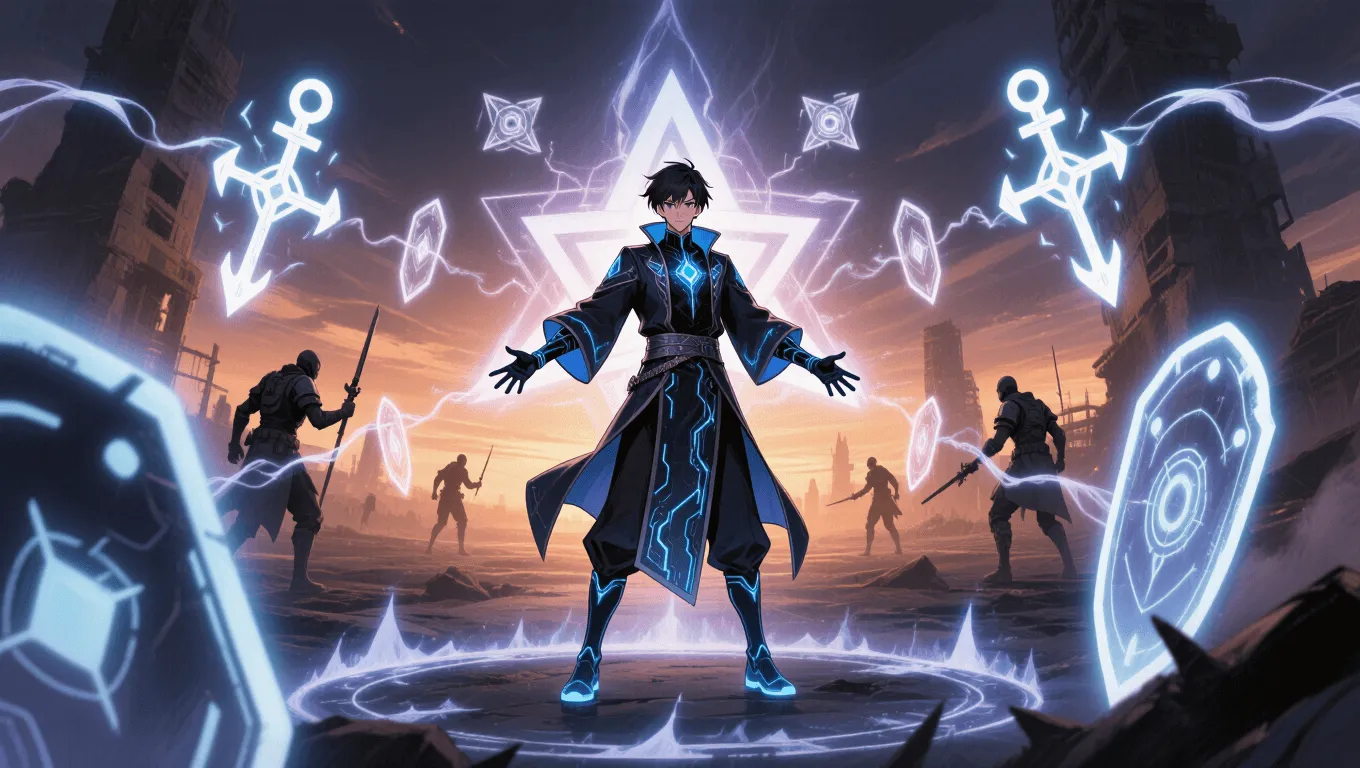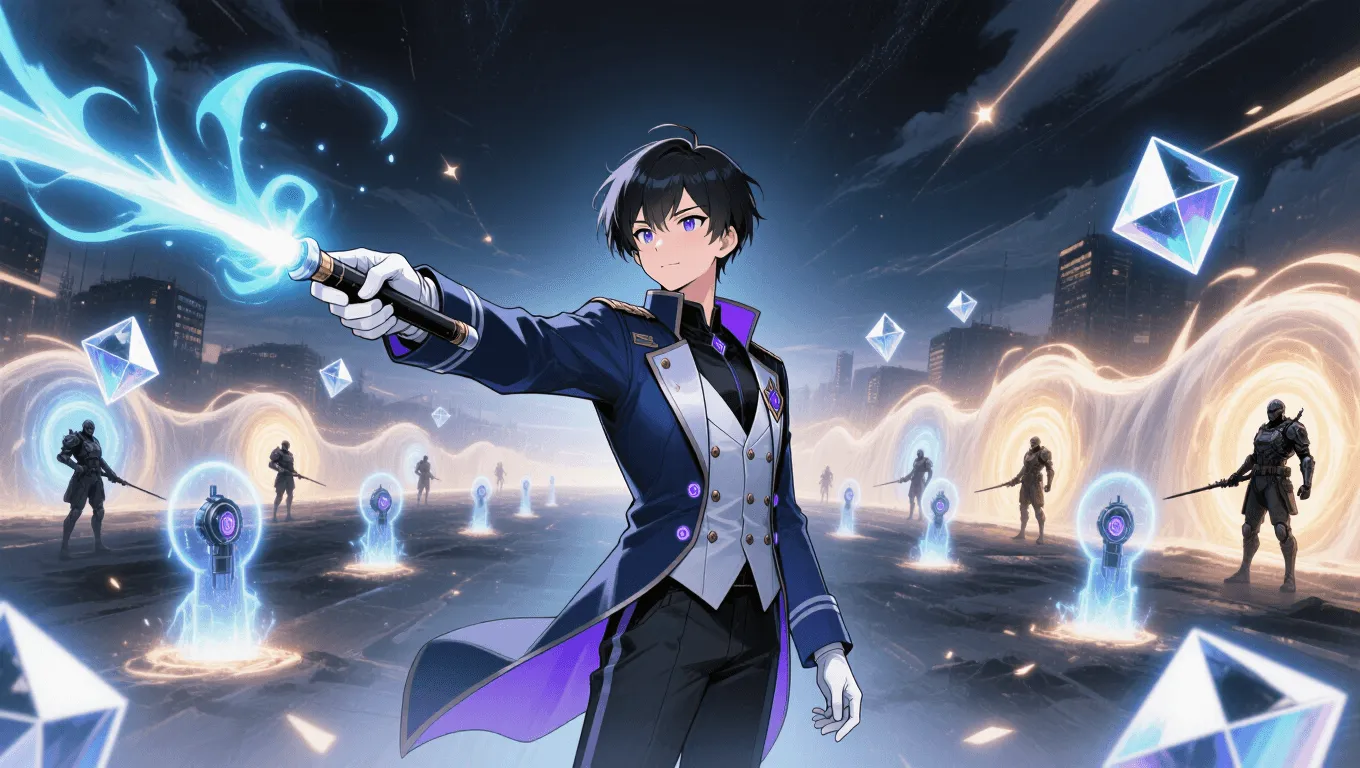Arcane Overture

Arcane Overture Video Demo 🎬
Table of Contents
- Arcane Overture Video Demo 🎬
- What Is Arcane Overture
- Core Abilities of Arcane Overture
- Application / Tactical Advantages in Combat
- Level: Level 1 🏙️, Level 2 🌇, Level 3 🌃
- Limitations of Using the Arcane Overture
- Weakness Against What Other Superpowers
- Synergistic Power Combos
- Practical Play Patterns
- Training and Progression Tips
- Known Users
- Example Thematic Builds
- FAQs
Arcane Overture is a high-concept magic superpower that turns spellcasting into a staged performance, where each “movement” unlocks stronger effects as the sequence builds. In simple terms, the user strings together spells like notes in a song. Early phrases set tempo and control, later phrases deliver heavy impact. This article explains what Arcane Overture is, its core abilities, battlefield applications, level progression, limitations, counterplay, synergistic combinations, and notable users. For more powers like this, browse the superpower list or try something new with the random superpower generator.
What Is Arcane Overture
Arcane Overture is a form of structured magic that channels mana through musical phrasing, sigils, and rhythm. Instead of isolated spells, the user performs an overture: an opening suite of coordinated techniques that establish a theme (element, school, or effect), then develops it through variations. When the sequence is executed cleanly, the magic resonates, amplifying range, potency, and precision. Breaking rhythm reduces output; completing the final cadence triggers a crescendo with dramatically enhanced results.
In worldbuilding terms, Arcane Overture sits between ritual magic and dynamic spellcasting. It is faster than full ceremonies but more disciplined than spontaneous casting. Its design rewards planning, timing, and situational awareness.
Core Abilities of Arcane Overture
Sequenced Spellcasting
The user casts spells in ordered phrases. Each phrase adds a stacking resonance that increases effectiveness (damage, control strength, duration, or area) up to a cap determined by the user’s skill and stamina.
Thematic Modulation
An overture can “lock” onto a theme—such as frost, gravity, light, or warding—so subsequent spells in that theme cost less mana and gain better synergy. Modulation allows switching themes mid-combat at a penalty to stacks.
Harmonic Resonance Buffs
Maintaining tempo generates harmonic resonance: subtle buffs like improved casting speed, smoother channeling under pressure, or resistance to magical collisions. These fade quickly if the sequence is interrupted.
Crescendo Finishers
At peak stacks, the user can discharge a finisher that converts accumulated resonance into a single, decisive effect: a wide-area pulse, a layered barrier, a precision “solo” strike, or a battlefield-scale enchantment.
Counterpoint Casting
Advanced users weave counterpoint—secondary micro-spells slotted between primary phrases—to conceal intentions, mask casting tells, or bait enemy counters. These are low-cost, high-utility inserts.
Conductor’s Field
A localized aura that aligns allied magic to the user’s rhythm. Allies who time their abilities to the beat gain minor cooldown relief, cleaner targeting arcs, and reduced friendly-fire risk.
Sigil Notation and Glyph Memory
The power stores frequently used phrases as sigil-sets that can be deployed rapidly. Think of them as macros: reliable, pre-etched patterns the user can trigger when time is tight.
Application / Tactical Advantages in Combat
Tempo Control
Arcane Overture excels at tempo. Opening with crowd control and wards establishes a safe pace; mid-sequence ramps damage; the finish converts advantage into a decisive blow. In skirmishes, this rhythm makes outnumbered fights manageable. In raids, it amplifies team timing.
Information Warfare
Sequenced casting telegraphs intent—but also allows feints. Users can reset tempo, insert pauses, or flip themes to punish opponents who try to read patterns. Counterpoint casting is especially potent against reactive foes.
Resource Efficiency
Because themes reduce mana costs over time, prolonged engagements tilt toward the overture user. Even modest spells grow impactful when layered rhythmically, turning attrition into a winning strategy.
Zone Denial and Space Shaping
Crescendos can redraw a battlefield: expanding wards, freezing terrain, dampening sound, or generating gravity wells. These effects funnel enemies and protect squishier allies.
Anti-Counterspell Play
While overt, the structure helps survive counter-magic. If an enemy cancels a phrase, the user can continue on off-beat with a pre-saved sigil pattern, preserving some stacks and preventing a total collapse.
Level: Level 1 🏙️, Level 2 🌇, Level 3 🌃
Level 1 🏙️ — Apprentice Conductor

-
Sequence Length: 3–4 phrases before a basic crescendo.
-
Themes: One primary theme per encounter; switching resets stacks.
-
Core Toolkit: Simple control (binds, slows), small wards, medium-range bolts.
-
Strengths: Reliable tempo setup, easy-to-learn sigil notation, low mana footprint.
-
Weaknesses: Susceptible to interruption, visible tells, limited finishers.
-
Typical Finisher: Focused “solo” strike or compact barrier dome.
Level 2 🌇 — Orchestrator

-
Sequence Length: 6–8 phrases with stable stack retention through brief disruptions.
-
Themes: Two active themes with reduced switch penalty; thematic modulation becomes practical.
-
Core Toolkit: Layered wards, mid-tier constructs (floating shields, anchor points), battlefield utility (silence pockets, wind lanes).
-
Strengths: Efficient mana economy, viable counterpoint casting, moderate Conductor’s Field for allies.
-
Weaknesses: Complex timing windows; mis-sequencing causes resonance decay.
-
Typical Finisher: Wide-area pulse, terrain-altering enchantment, or teamwide buff aligned to the theme.
Level 3 🌃 — Maestro of the Overture

-
Sequence Length: 10+ phrases, resilient stacks, and recovery options after heavy disruption.
-
Themes: Fluid tri-theme modulation (e.g., light, gravity, and warding) without full reset.
-
Core Toolkit: Long-duration constructs (arcane turrets, reflective prisms), selective dispels, phase gates, and large anti-projectile curtains.
-
Strengths: Battlefield dominance through rhythm, precise ally synchronization, double-layer crescendos (two finishers linked).
-
Weaknesses: Noticeable prep time at the start; high cognitive load; risk of overextension if the overture drags.
-
Typical Finisher: Dual-cadence event—e.g., gravity well into radiant shatter, or fortress ward into seek-and-silence storm.
Limitations of Using the Arcane Overture
-
Rhythm Dependency: Losing tempo collapses resonance. Stuns, silences, or environmental hazards can reset progress.
-
Line-of-Sight and Acoustics: While not literal music, audible or kinetic cues help alignment. Heavy interference, vacuum, or chaotic soundscapes can hamper precision.
-
Mana Drought: Efficiency grows over time, but the opening is resource hungry. Early failure wastes mana and invites counters.
-
Pattern Exposure: Smart enemies learn favorite phrases. Overreliance on memorized sigils becomes predictable.
-
Cognitive Strain: High-level users juggle cadence, counters, space, and team coordination—long fights risk mistakes.
-
Cooldown Windows: Crescendos impose a brief refractory period in which stacks clear and casting slows.
Weakness Against What Other Superpowers
-
Anti-Magic/Nullification: Abilities like magic dampening fields, mana burns, or entropy veils erase stacks and mute crescendos.
-
Pure Disruption: Teleport shunts, time janks, and stochastic fields insert off-beat delays that desynchronize the sequence.
-
Instantaneous Burst Powers: One-shot alpha strikes or teleport-to-melee styles punish the overture’s early setup.
-
Perfect Silence/De-synchronizers: Powers that scramble rhythm—time-scramble, echo scatter, or resonance inversion—force misfires.
-
Reflective Warding Specialists: Opponents who turn sequences back on the caster can weaponize the user’s own crescendo timing.
Synergistic Power Combos
Guardian’s Metronome (Arcane Overture + Shield/Barrier Mastery)
A tank ally anchors the rhythm by absorbing interrupts. The overture rides that stability, delivering consistent crescendos. Ideal for objective defense and choke-point battles.
Storm Orchestra (Arcane Overture + Weather/Elemental Control)
Elemental controllers set environmental “time signatures” (steady winds, rolling thunder). The user locks theme to the weather, gaining cheap, stacked effects that feel inevitable.
Rogue’s Syncopation (Arcane Overture + Stealth/Illusion)
An infiltrator manufactures off-beat distractions while the caster hides counterpoint phrases inside visual noise. Enemies misread the sequence, wasting counters.
Gravity Chorus (Arcane Overture + Gravity/Spatial Bending)
Spatial bends reshape lines of fire to match the beat. Crescendos land where corridors converge, multiplying impact without additional mana.
Healer’s Cadenza (Arcane Overture + Restoration/Regeneration)
Timed heals as “grace notes” sustain the caster through the opening. The final cadence can convert resonance into a teamwide cleanse or rapid stabilization field.
Practical Play Patterns
Opening Phrases: Establish and Test
Start with a theme probe: a minor control or ward that reveals whether opponents have counters ready. Insert a counterpoint flicker—like a quick dispel or decoy sigil—to measure their reaction time. If they bite, shift tempo.
Middle Phrases: Build and Threaten
Commit to a theme and ladder resonance through repeated on-theme spells. Intermix utility phrases—silence lances, anchor sigils, denial arcs—to tighten space. Keep mana costs low by staying in-theme.
Final Cadence: Convert and Reset
When stacks peak, choose a finisher that converts advantage into state change: remove cover, collapse shields, open a route, or freeze a retreat path. Immediately after, adopt a defensive micro-sequence while the refractory cooldown ticks.
Training and Progression Tips
-
Practice with a metronome analogue—heartbeat counting or finger signals—to internalize tempo without sound.
-
Create three sigil notebooks: control, warding, and finisher. Drill transitions between them until switching themes costs minimal stacks.
-
Record sparring sessions to identify predictable openings. Replace the most recognizable phrase with a different glyph pattern every week.
-
Learn at least one disruptive micro-spell per opponent archetype: blink-jam for teleporters, shatter note for barrier reflectors, or echo-cancel for illusionists.
-
Coordinate callouts with teammates to align abilities to the Conductor’s Field window.
Known Users
-
Court Maestros of Virelda — aristocratic battlemages who turned sieges into staged spectacles, famous for dual-cadence crescendos that collapsed fortress gates at dusk.
-
The Lattice Choir — a clandestine order that taught overture phrasing to city guardians, emphasizing ward themes and ally synchronization.
-
The Wandering Impresario — a traveling mage whose duels resembled concerts; every bout began with a “curtain-raise” silence before a blinding finisher.
-
Comics Parallel: Characters skilled in structured spellcasting and ritual rhythm echo aspects of this power. For example, Doctor Strange often combines layered wards, thematic modulation, and timed finishers—concepts that align with overture-style magic—though his lore uses broader mystic frameworks.
Example Thematic Builds
Frost Overture
Phrases: frost bind → rime ward → hail puncture → glacial anchor → crescendo: permafrost wave.
Use: Control-heavy setups, pursuit denial, and safe objective play.
Counter: Heat manipulation or rapid reposition.
Light Overture
Phrases: lens flare → prism ward → luminant tether → silence beam → crescendo: radiant shatter.
Use: Anti-illusion, anti-ambush, and morale-breaking displays.
Counter: Darkness fields, reflective barriers, or dispersion veils.
Gravity Overture
Phrases: mass whisper → vector knot → slowfall curtain → pinch point → crescendo: eventide well.
Use: Corridor fights, area denial, projectile suppression.
Counter: Teleportation, inertial dampening, or anti-singularity wards.
FAQs
Is Arcane Overture the same as ritual magic?
No. Rituals rely on lengthy preparation and fixed circles. Arcane Overture is a live performance—shorter than rituals, longer than instant cantrips—and trades speed for compounding synergy.
Does it require sound?
Not strictly, but rhythm helps. Skilled users can internalize counts through somatic patterns or mental metering. Silence fields make things harder, not impossible.
Can it be used stealthily?
At low intensity, yes. Counterpoint casting and muted somatics allow discreet phrases. Large crescendos, however, are inherently conspicuous.
What happens if a phrase is perfectly countered?
Stacks dip and the harmonic window narrows. With good sigil memory, the user can pivot themes or bridge with a neutral utility phrase to salvage momentum.
For more entries like Arcane Overture, explore the full superpower list. Want a fresh idea for your next character? Try the random superpower generator.
